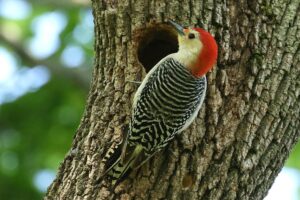
What can you see outside in winter and early spring? Our local woodpeckers live here year-round but are easier to spot when the leaves are down and woodpeckers peck noisily. You might see a relative newcomer, the red-bellied woodpecker, which is now the second-most-often-seen woodpecker in our area. It’s thriving.
Despite its name, you’ll probably notice red on the head of a red-bellied woodpecker (Melanerpes carolinus), not on its belly. Any red on the belly is faint and well hidden. Males have a showy red cap plus red on the back of the neck. Females have red just on the back of the neck. Both can look red-headed to us and have a black-and-white zebra pattern on their back. (A different woodpecker, called the red-headed woodpecker, Melanerpes erythrocephalus, has an all-red head but rarely shows up in our area.)
The red-bellied woodpecker’s size makes it conspicuous. It’s a medium-sized woodpecker, about 9 inches long. It’s larger than our most-often-seen woodpecker, the little 6-inch downy woodpecker (Dryobates pubescens) that frequents our birdfeeders or travels with chickadee flocks. Yet the red-bellied woodpecker is smaller than the somewhat prehistoric-looking 16-inch-plus pileated woodpecker (Dryocopus pileatus).
Red-bellied woodpeckers have been moving northward from the southeastern U.S., where they are most abundant. They were first confirmed as breeding in Massachusetts in 1977. Our area has become more suitable for them as the climate has warmed. The regrowth of forests in Massachusetts has also been good for these forest birds.
Why are they thriving? Part of their story is that they are flexible and not too specialized. Take their broad diet, for example. Like most woodpeckers, they forage for insects, spiders, and the like. You might see them doing this as they move up tree trunks and along branches, probing the bark with their chisel-like beaks and long, sticky, barbed tongues. But they also dine on seeds, fruits, and nuts such as acorns, especially in winter. They’ll even come to birdfeeders, where they like seeds, suet, fruit, and peanut butter (although they can’t get anything out of feeders that are set to close when large birds or squirrels land). With such a diet, they can feed in large forests and small wooded patches, using forest interiors and edges, and undeveloped landscapes and suburbs.
Another part of their story involves shelter. Red-bellied woodpeckers dig holes in dead or dying trees for roosting or nesting. They need dead trunks or branches that are large enough for a roomy nesting hole, and usually make a new nest hole each year, often in the same tree. They also make shallower holes for solitary roosting, which helps them survive cold nights. Big dead trees can be scarce, but fortunately, red-bellied woodpeckers find many potential sites for holes because they also use dead branches on living trees. Unfortunately, they face competition for nest holes from European starlings (Sturnis vulgaris), which can evict red-bellied woodpeckers.
What’s their nest hole like inside? You might spot a 2.3-inch entrance hole, but there’s much more: a horizontal tunnel leading 9-12 inches into the center of the tree, and then a downward cavity about 3-1/2 by 5 inches. A parent bird, 4 eggs (on average) laid on wood chips (no actual nest) – and eventually growing chicks – all fit inside.
In the weeks ahead, red-bellied woodpeckers will become even more obvious to us as they start to drum on hollow trees and other objects. It’s a way of announcing their breeding territory and attracting a mate (instead of singing). They’ll also call increasingly. They often make a rolling “kwirr” call that’s not hard to recognize (https://www.allaboutbirds.org/guide/Red-bellied_Woodpecker/sounds).
To attract a female, a male selects a nest hole site in his territory and starts digging, and also taps with his beak. A female that’s interested will join in digging the hole, which can take two weeks. Both birds warm the eggs, feed the chicks, and lead the young around for a while after they’ve fledged. A pair stays together for 7 months or so. They winter in separate but sometimes overlapping territories.
Enjoy watching and listening for red-bellied woodpeckers, and let’s hope this winter won’t be too harsh for them.
***
What else might you see outside in nature these days? Check out the WCLT Nature Notes articles listed for these months in our online monthly index.
Did you know that Westborough has 60 miles of trails, and WCLT has trail maps? The Westborough Community Land Trust (WCLT) preserves, protects, and promotes open space in Westborough (westboroughlandtrust.org and facebook.com/westboroughlandtrust).
***
Nature Notes is written for the Westborough Community Land Trust and re-published online by the Community Advocate.















